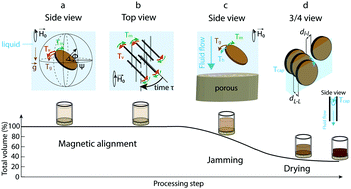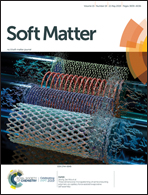Design of textured multi-layered structures via magnetically assisted slip casting†
Abstract
Multi-layered composites in nature often show functional properties that are determined by the specific orientation of inorganic building blocks within each layer. The shell of bivalve molluscs and the exoskeleton of crustaceans constitute prominent examples. An effective approach to artificially produce textured microstructures inspired by such complex composites is magnetically assisted slip casting (MASC). MASC is a colloidal process in which anisotropic particles are magnetically oriented at arbitrarily defined angles and collected at the surface of a porous mould to grow the material in an additive manner. Whereas a number of proof-of-concept studies have established the potential of the technique, the full design space available for MASC-fabricated structures, and the limits of the approach, have so far not been explored systematically. To fill this gap, we have studied both theoretically and experimentally the various torques that act on the particles at the different stages of the assembly process. We define the boundary conditions of the MASC process for magnetically responsive alumina platelets suspended in a low-viscosity aqueous suspension, considering the composition of the colloidal suspension and the dynamics of the particle alignment process under a rotating magnetic field. These findings lead to design guidelines for the fabrication of bio-inspired composites with customized multi-scale structures for a broad range of applications.



 Please wait while we load your content...
Please wait while we load your content...